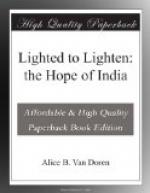But, though wife and mother and home maker, Mrs. Azariah’s interests extend far beyond the confines of her family. She is president of the Madras Mothers’ Union, and editor of the little magazine that travels to the homes of Tamil and Telugu Christian women, their only substitute for the “Ladies’ Home Journal” and “Modern Priscilla.” She is also the teacher of the women’s class, made up of the wives of the theological students. A Tamil woman in a Telugu country, she, too, must have known a little of the linguistic woes of the foreign missionary. Those days, however, are long past, and she now teaches her daily classes in fluent and easy Telugu. There are also weekly trips to nearby hamlets, where the women-students are guided by her into the ways of adapting the Christian’s good news to the comprehension of the plain village woman, whose interests are bounded by her house, her children, her goats, and her patch of millet.
Such a village we visited that same Sunday, when toward evening the Bishop, Mrs. Azariah, and I set out to walk around the Dornakal domain. We saw the gardens and farm from which the boys supply the whole school family with grain and fresh vegetables; we looked up to the grazing grounds and saw the herd of draught bullocks coming into the home sheds from their Sunday rest in pasture. I was told about the other activities which I should see on the working day to follow—spinning and weaving and sewing, cooking and carpentry and writing and reading—a simple Christian communism in which the boys farm and weave for the girls, and the girls cook and sew for the boys, and all live together a life that is leading up to homes of the future.
It was after all that that we saw the village. On the edge of the Mission property we came to the small group of huts, wattled from tree branches and clay, inhabited by Indian gypsy folk, just settling from nomadism into agricultural life. So primitive are they still, that lamp light is taboo among them, and the introduction of a kerosene lantern would force them to tear down those attempts at house architecture and move on to a fresh site, safe from the perils of civilization. It is among such primitive folk that Mrs. Azariah and her students carry their message. Herself a college woman, what experiment in sociology could be more thrilling than her contact with such a remnant of the primitive folk of the early world?
Mother, home-maker, editor, teacher, evangelist, with quiet unconsciousness and utter simplicity she is building her corner of Christian India.
Public Service.
“To-morrow is the day of the Annual Fair and I am so busy with arrangements that I had no time even to answer the note you sent me yesterday.” No, this was not said in New York or Boston, but in Madras; and the speaker was not an American woman, but Mrs. Paul Appasamy, the All-India Women’s Secretary of the National Missionary Society.
[Illustration: MRS. PAUL APPASAMY]




